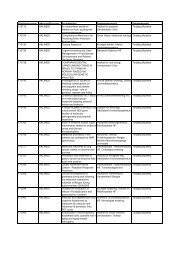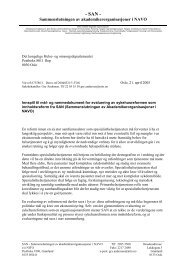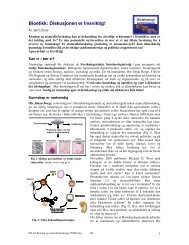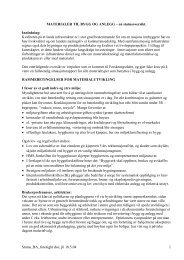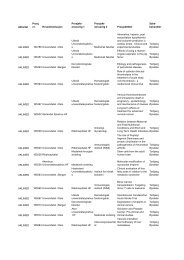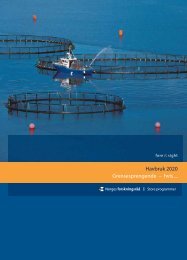A Revolution in R&D
A Revolution in R&D
A Revolution in R&D
Create successful ePaper yourself
Turn your PDF publications into a flip-book with our unique Google optimized e-Paper software.
GENOTYPING—HOPES RISE AS PRICES FALL<br />
For companies wish<strong>in</strong>g to pursue disease genetics,<br />
one of the major stumbl<strong>in</strong>g blocks has been the prohibitive<br />
cost of genotyp<strong>in</strong>g. The current average<br />
genotyp<strong>in</strong>g cost <strong>in</strong> the <strong>in</strong>dustry is about 50 cents per<br />
SNP. At that price, even narrow candidate-gene studies<br />
could cost as much as $15 million; a direct<br />
genome-wide association study could cost upwards<br />
of $5 billion.<br />
Matters are about to change, however. Costs are<br />
decl<strong>in</strong><strong>in</strong>g, and are expected to cont<strong>in</strong>ue to fall dramatically—as<br />
much as 50-fold—over the next few<br />
years, thanks to competition and customer demand<br />
on the one hand, and improved automation and<br />
“Genotyp<strong>in</strong>g—Hopes Rise as Prices Fall.”) And<br />
once that happens, the two major questions outstand<strong>in</strong>g<br />
can be resolved: the number of patients<br />
needed to atta<strong>in</strong> statistically significant results, and<br />
the utility of SNP maps.<br />
Regard<strong>in</strong>g patient populations, first: the more<br />
patients, of course, the easier it is to discern a true<br />
difference above randomly occurr<strong>in</strong>g fluctuations<br />
(noise)—and the more expensive. Size your sample<br />
too spar<strong>in</strong>gly, and you risk emerg<strong>in</strong>g empty-handed;<br />
too generously, and you overspend. Strik<strong>in</strong>g the<br />
right balance is tricky. It depends on how common<br />
the sought-for SNPs are, and that is very difficult to<br />
estimate. It also depends on the strength of the<br />
association between the disease and the suspect<br />
polymorphism. For common multigenic diseases,<br />
susceptibility depends on a specific comb<strong>in</strong>ation of<br />
several genetic changes, and is <strong>in</strong>fluenced by environmental<br />
factors as well, which weakens the association.<br />
The weaker the association, the larger the<br />
sample needed to detect the <strong>in</strong>fluence of a specific<br />
gene. Perhaps the issue will dissolve before be<strong>in</strong>g<br />
resolved. If prices plummet as expected, and if<br />
databases become as comprehensive as hoped, sufficient<br />
sample sizes will become easily affordable.<br />
SNP maps can help <strong>in</strong> the quest to identify a<br />
disease-susceptibility gene, but only if two condi-<br />
m<strong>in</strong>iaturization (which allows companies to reduce<br />
their consumption of expensive reagents) on the<br />
other.<br />
Our calculations are, accord<strong>in</strong>gly, based on a cost of<br />
one cent per SNP genotype—a likely price across the<br />
<strong>in</strong>dustry, accord<strong>in</strong>g to expert consensus, with<strong>in</strong> the<br />
next five years. (Some companies must already be<br />
benefit<strong>in</strong>g from genotyp<strong>in</strong>g costs considerably lower<br />
than the current <strong>in</strong>dustry average.) That said, the<br />
cost of conduct<strong>in</strong>g disease genetics studies will<br />
rema<strong>in</strong> far from negligible, and companies will need<br />
to cont<strong>in</strong>ue to take it <strong>in</strong>to account when assess<strong>in</strong>g<br />
risk.<br />
tions prevail. First, for any association studies<br />
(whether narrow or broad) to work, the genetic variants<br />
associated with the disease need to be fairly<br />
common—prevalent <strong>in</strong> more than 1 percent of the<br />
population at large—and that is far from guaranteed.<br />
Then, these polymorphisms need to be either<br />
recognizable (that is, they must produce discernible<br />
changes <strong>in</strong> a prote<strong>in</strong>) or at least detectable by an<br />
<strong>in</strong>direct measure (called l<strong>in</strong>kage disequilibrium;<br />
that is, the presence of a particular SNP cluster <strong>in</strong><br />
<strong>in</strong>dividuals with a given disease). Assum<strong>in</strong>g reasonable<br />
costs, <strong>in</strong>direct genome-wide association studies—of<br />
all the approaches, the one most likely to<br />
prevail—would, accord<strong>in</strong>g to our model, result <strong>in</strong> a<br />
total sav<strong>in</strong>gs of $395 million <strong>in</strong> cost per drug on average,<br />
with 0.7 years of time saved to market (produc<strong>in</strong>g<br />
an additional $260 million of value per drug).<br />
Of course, for that to happen, you need to do more<br />
than f<strong>in</strong>d disease genes—you have to turn them to<br />
good effect by ultimately produc<strong>in</strong>g a drug. And<br />
here disease genetics presents a further challenge:<br />
given the long odds <strong>in</strong>volved <strong>in</strong> pharmaceutical<br />
R&D, will the number of targets yielded by disease<br />
genetics be sufficient?<br />
Practicability—the Limitations of Human Studies<br />
The problem is that human studies—identify<strong>in</strong>g<br />
polymorphic genes <strong>in</strong> humans—will tend to pro-<br />
31



